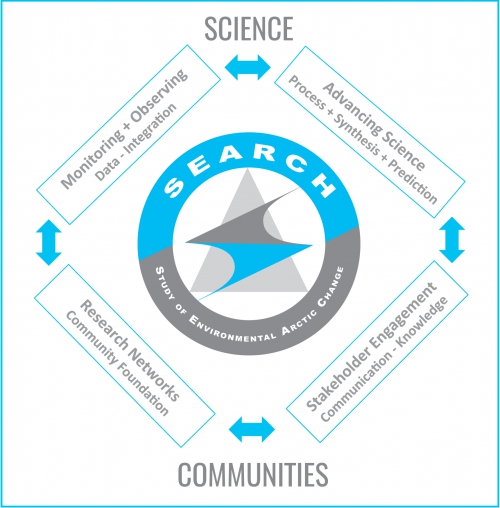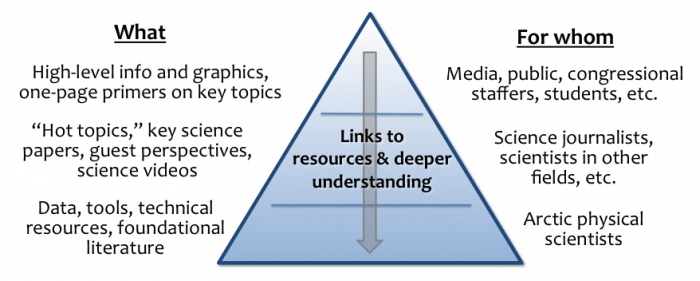This update on the Study of Environmental Arctic Change (SEARCH) program includes recent news highlights from each of SEARCH's three Action Teams as well as reports from the Sea Ice Prediction Network and the Arctic Observing Open Science meeting.
SEARCH Action Team Highlights

During the SEARCH annual planning meeting that convened 19-20 November 2015 following the Arctic Observing Science Meeting, a shared knowledge-to-action framework was developed to encourage greater coordination and integration across each of SEARCH's three action teams (See Figure 1).
The framework emphasizes meaningful exchanges across disciplines and significant interactions between researchers and stakeholders, and encourages the cultivation of new scientific knowledge, understanding, and critical observational capabilities.
Using the framework as a guide, Action Team leaders are now sharing what they have learned after their first year of activities with one another. Together, they are identifying new opportunities to increase each Action Team's overall capacity to address SEARCH's five-year science goals and to provide a stronger foundation for Arctic change science and research.
The Permafrost Action Team: Document and Understand How Degradation of Near-Surface Permafrost Will Affect Arctic and Global Systems
In its first year, SEARCH's Permafrost Action Team has experienced great success in the areas of research community network building and synthesis science production. This is due, in part, to the fact that the Permafrost Carbon Network (PCN) was already quite mature when it was absorbed as a project of the SEARCH Permafrost Action Team. Now in its 5th year, the PCN was able to attract over 120 members of the permafrost research community to its annual meeting this December to help explore and advance 11 new synthesis science projects.
A comprehensive report on the Permafrost Carbon Network's activities over the past five years is now available for download. SEARCH's Action Team leaders are looking to the lessons learned by the PCN over this timeframe as they work to expand their own research networks and stimulate new Arctic change science and knowledge production.
The Sea Ice Action Team: Improve Understanding, Advance Prediction, and Explore Consequences of Changing Arctic Sea Ice
In its first year, the Sea Ice Action Team has led SEARCH's efforts to develop a strategy for sharing scientific knowledge and expertise across the many boundaries that typically constrain scientific disciplines. A good example of this leadership in action was the Climate Change Communication Workshop that the Sea Ice Action Team hosted at the Fall AGU meeting.
In the year to come, SEARCH's Action Team leads will further leverage the Sea Ice Action Team strategy to promote new knowledge production and to support scientific collaboration across disciplines. Using a "knowledge pyramid" approach to identify target audiences and content (See Figure 2), the Sea Ice Action Team is working with the research community to compile existing literature and data on important sea ice topics and to synthesize these materials for wider use and consumption. In this way, the Sea Ice Team also hopes to spotlight information gaps requiring additional research.

The Land Ice Action Team: Improve Predictions of Future Land Ice Loss and Impacts on Sea Level
In the past year, the work of the Land Ice Action Team has advanced SEARCH's efforts to prioritize key Arctic observing needs through the facilitation of a coordinated Greenland Ice Sheet/Ocean Observing System (GrIOOS) with the international research community.
A GrIOOS development workshop was held 12-13 December 2015 in San Francisco, California. The purpose of the workshop, led by SEARCH Action Team Lead Fiamma Straneo of Woods Hole Oceanographic Institution, was to identify a design and implementation plan for establishing a long-term observatory focused on ice sheet/ocean interactions in Greenland, including the impact of ice sheet changes on the marine environment. The workshop attracted over 50 scientists from 10 countries, covering a wide range of disciplines, and included a large number of early career scientists. Discussion topics included establishing the minimum observations to be collected, existing monitoring networks around Greenland, and identifying a list of prioritized sites. By the conclusion of the two-day workshop, the group was able to shorten the list of locations to five key areas with a representative set of measurements that varied slightly depending upon site characteristics. The GrIOOS Workshop was productive, cross-disciplinary, and a great step toward setting the Land Ice Action Team in motion.
Sea Ice Prediction Network: A Contribution to SEARCH
The Sea Ice Prediction Network (SIPN) published the 2015 Sea Ice Outlook post-season report in December 2015. Developed by the 2015 Sea Ice Outlook Action Team, the SIPN Leadership team, and with input from community members, it includes a review of the Arctic summer conditions, a pan-Arctic overview, a summary of local-scale analysis, discussion of the modeling and statistical contributions, and a summary of lessons learned from the 2015 Sea Ice Outlook as well as recommendations for the 2016 Sea Ice Outlook.
SIPN also held an open workshop to discuss data needs for sea ice forecasting on 17 December during the 2015 American Geophysical Union (AGU) fall meetings. This workshop focused on how SIPN and others who provide data observations can best serve the needs of the forecasting community. The goals of the workshop were to help identify data needs for model initialization and verification, which available data products are useful and why, what improvements to existing data products would make for better utilizations (e.g., change in formatting), what additional observations are needed, and how limited spatial scale data (e.g.,from ship observations) are being used. Presentations from the workshop are available here.
Plans for upcoming events include the 2016 Sea Ice Prediction Workshop, which will convene 4-6 May at Lamont-Doherty Earth Observatory in New York. This workshop will focus on sources of polar predictability on the sub-seasonal to inter-annual timescales, sea ice prediction, and operational and research efforts. The meeting will include a series of invited talks as well as contributed presentations and poster sessions. Outcomes of the meeting will include recommendations for the Sea Ice Outlook and other activities related to polar prediction.
The 2016 SIPN Webinar series will begin on Tuesday, 22 March with a presentation entitled "Challenges and Best Practices: Sea Ice Thickness Distribution as a Rosetta Stone for Cross-Scale Communication" by Cathleen Geiger, Sea Ice Geophysicist at the University of Delaware. Registration will be announced via ArcticInfo and the SIPN Mailing List.
The 2015 Arctic Observing Open Science Meeting (AOOSM)
The Arctic Observing Open Science Meeting (AOOSM) was held in Seattle, Washington during 17-19 November 2015. More than 200 people attended the meeting. The meeting provided an opportunity for the Arctic science community to present and discuss findings and advances in Arctic observing research. The meeting was organized by the Arctic Research Consortium of the United States (ARCUS) and a 13-member Organizing Committee, and was supported by NSF's Arctic Observing Network program along with other contributors.

The primary goals of AOOSM were to: 1) present and discuss scientific findings and advances resulting from Arctic observing projects; 2) discuss operational and technological achievements of observing science projects and efforts funded through U.S. local, state, and federal agencies, and private and non-profit organizations; 3) explore how well new observational achievements meet major science goals; 4) identify opportunities for collaboration to develop high impact scientific synthesis products and papers; and 5) strengthen the goals, identity, and activities of an integrated Arctic Observing System. The Organizing Committee addressed these goals with a diverse, effective agenda of plenary presentations, parallel sessions with extended discussion, a poster session, and an agency panel discussion. In total, there were 99 presentations in the parallel sessions and 42 posters.
The agency panel discussion addressed the overarching goal of achieving an interagency Arctic observing system. Eight agency representatives provided brief presentations addressing the unique objectives of their respective organizations, descriptions of current and ongoing observations, and how they envision their agency's role in an interagency Arctic observing network.
Parallel sessions were held during all three days of the meeting, covering 11 different topics. A unique feature of each session was an open discussion period of 45–60 minutes following the presentations, chaired by an organizing committee member.
Post-meeting survey results were overwhelmingly positive and most participants indicated that more regular Arctic observing meetings would be beneficial. Abstracts and presentations from plenary, agency, and parallel session speakers have been made publicly available on the ARCUS meeting webpage. Further meeting products including session summaries, a meeting report and possible peer-review publications are also in progress. Any questions or comments regarding AOOSM can be directed to Judy Fahnestock (judy [at] arcus.org).
AOOSM agenda, organizing committee, and presentations are available here.
